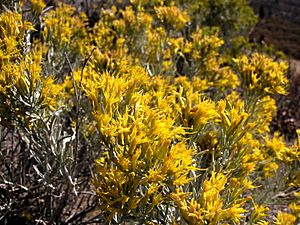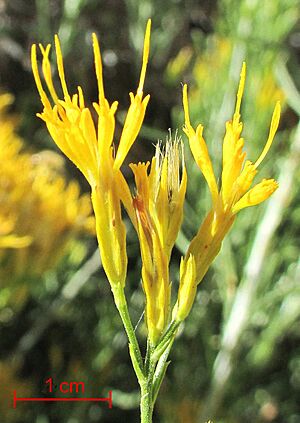Ericameria nauseosa facts for kids
Quick facts for kids Ericameria nauseosa |
|
|---|---|
 |
|
| Ericameria nauseosa in Oregon | |
| Scientific classification | |
| Kingdom: | |
| (unranked): | |
| (unranked): | |
| (unranked): | |
| Order: | |
| Family: | |
| Tribe: |
Astereae
|
| Genus: |
Ericameria
|
| Species: |
E. nauseosa
|
| Binomial name | |
| Ericameria nauseosa (Pall. ex Pursh) G.L.Nesom & G.I.Baird
|
|
| Synonyms | |
|
Synonymy
Chondrophora nauseosa (Pall. ex Pursh) Britton
Chrysothamnus nauseosus (Pall. ex Pursh) Britton Chrysocoma nauseosa]] Pall. Chrysothamnus frigidus Greene Bigelowia nauseosa M.E.Jones Chrysothamnus collinus Greene Chrysothamnus concolor (A.Nelson) Rydb. Chrysothamnus pallidus A.Nelson Aster edwardii Kuntze Bigelowia juncea Greene Chrysothamnus junceus (Greene) Greene Chrysothamnus plattensis (Greene) Greene Machaeranthera scabrella (Greene) Shinners, syn of var. ammophila Aster binominatus Kuntze, syn of var. bigelovii Bigelowia bigelovii (A.Gray) A.Gray, syn of var. bigelovii Chrysothamnus bigelovii (A.Gray) Greene, syn of var. bigelovii Chrysothamnus glareosus (M.E.Jones) Rydb., syn of var. bigelovii Chrysothamnus moquianus Greene, syn of var. bigelovii Linosyris bigelovii A.Gray, syn of var. bigelovii Bigelowia ceruminosa (Durand & Hilg.) A.Gray, syn of var. ceruminosa Chrysothamnus ceruminosus (Durand & Hilg.) Greene, syn of var. ceruminosa Linosyris ceruminosus Durand & Hilg., syn of var. ceruminosa Chrysothamnus angustus Greene, syn of var. consimilis Chrysothamnus confinis Greene, syn of var. consimilis Chrysothamnus consimilis Greene, syn of var. consimilis Chrysothamnus falcatus Greene, syn of var. consimilis Chrysothamnus patens Rydb. syn of var. consimilis Chrysothamnus pinifolius Greene, syn of var. consimilis Chrysothamnus tortuosus Greene, syn of var. consimilis Bigelowia graveolens (Nutt.) A.Gray, syn of var. graveolens Chrysocoma graveolens Nutt., syn of var. graveolens Chrysothamnus dracunculoides (DC.) Nutt., syn of var. graveolens Chrysothamnus graveolens (Nutt.) Greene, syn of var. graveolens Chrysothamnus laetevirens Greene, syn of var. graveolens Chrysothamnus virens Greene, syn of var. graveolens Linosyris graveolens (Nutt.) Torr. & A.Gray, syn of var. graveolens Chrysothamnus gnaphalodes (Greene) Greene, syn of var. hololeuca Chrysothamnus appendiculatus (Eastw.) A.Heller, syn of var. latisquamea Chrysothamnus arizonicus (Greene) Greene, syn of var. latisquamea Chrysothamnus latisquameus (A.Gray) Greene, syn of var. leiosperma Aster leiospermus (A.Gray) Kuntze, syn of var. leiosperma Bigelowia leiosperma A.Gray, syn of var. leiosperma Chrysothamnus leiospermus (A.Gray) Greene, syn of var. leiosperma Aster mohavensis (Greene) Kuntze, syn of var. mohavensis Bigelowia mohavensis Greene, syn of var. mohavensis Bigelowia mohavensis Greene ex A.Gray, syn of var. mohavensis Chrysothamnus mohavensis (Greene) Greene, syn of var. mohavensis Bigelowia glareosa M.E.Jones, syn of var. psilocarpa Chrysothamnus salicifolius Rydb., syn of var. salicifolia Chrysothamnus californicus Greene, syn of var. speciosa |
|

Ericameria nauseosa (say: air-uh-kuh-MAIR-ee-uh NAW-see-OH-suh) is a common plant known by many names like Chamisa, rubber rabbitbrush, and gray rabbitbrush. It is a shrub that belongs to the sunflower family. You can find it growing in dry areas across western Canada, the western United States, and northern Mexico.
Scientists used to call this plant Chrysothamnus nauseosus. But after studying its family tree, they moved it to the Ericameria group in 1993. This change helps us understand how different plants are related.
Contents
What it Looks Like
Growth and Size
Ericameria nauseosa is a perennial shrub, meaning it lives for more than two years. It can grow to be anywhere from 2 to 8 feet tall. This plant can grow new plants from its seeds or from its roots.
Flowers and Leaves
This shrub blooms with bright golden-yellow flowers from August to October. The flowers have a strong smell. Each flower cluster is made up of 5 small, yellow, tube-shaped flowers. These clusters often form an umbrella shape at the ends of the branches.
The leaves of the rubber rabbitbrush can be long and thin or shaped like a spatula. Both the flexible stems and the leaves have a soft, felt-like covering and are a greenish-gray color.
Types of Rabbitbrush
There are different types of Ericameria nauseosa. Scientists have grouped them into two main subspecies:
- Ericameria nauseosa subsp. consimilis (the green form)
- Ericameria nauseosa subsp. nauseosa (the gray form)
Each of these subspecies also has many different varieties. These varieties often look slightly different and grow in specific areas, like sandy deserts or rocky slopes.
Growing Rabbitbrush
Rubber rabbitbrush is becoming a popular plant for xeriscaping. This is a way of gardening that uses plants which need very little water. It's a great choice for dry places because it can grow well in many types of sandy or rocky soils. These soils are often found in desert areas.
To keep the shrub looking its best, people sometimes trim it back in early spring. This helps it grow new, healthy branches.
Food for Animals
Rubber rabbitbrush is an important food source for many wild animals, especially in winter. Animals like deer, elk, and rabbits eat its branches and leaves. You might see many of these shrubs growing in areas where the land has been disturbed, like along roadsides or on old farms.
Uses of the Plant
Traditional Uses
The Zuni people have used the bigelovii variety of the nauseosa subspecies for centuries. They use the bright yellow flowers to make a yellow dye. They also use the strong stems to weave baskets.
Future Possibilities
For a long time, people have thought about using rubber rabbitbrush to make rubber. Studies were done during World War I and II, and again in 1987, to see if it could be a good source of rubber.
Today, scientists are still studying this plant. Researchers are looking into using it for special materials and even for energy. One exciting idea is to use it to make rubber for people who are allergic to regular latex. This could help many people!
Interesting Fact
Some rubber rabbitbrush plants growing near Los Alamos, New Mexico, have shown something very unusual. Their roots reached into an old nuclear waste area. Because of this, they absorbed a radioactive substance called strontium-90. These plants had a much higher amount of this substance than normal plants. You wouldn't be able to tell them apart from other shrubs just by looking, but a special device called a Geiger counter could detect the radioactivity.
Gallery
-
Rabbitbrush native to the area near the post office in Crestone, Colorado
Images for kids






